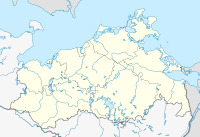Conventer See nature reserve
Coordinates: 54 ° 8 '30.9 " N , 11 ° 53' 8.4" E
The Conventer See nature reserve is a 216 hectare nature reserve in the municipality of Börgerende-Rethwisch in Mecklenburg-Western Pomerania . It is a beach lake, sealed off by coastal protection systems, which is of great importance for the bird world as a breeding and resting area. The protected area includes the Conventer See with adjacent areas and is located between the towns of Heiligendamm and Börgerende about three kilometers north of Bad Doberan . The designation took place on October 18, 1939. The state of the area is classified as unsatisfactory, since material inputs, drainage and dredging have negative effects. An insight into the protected area is possible from the Jemnitz barrier. The actual areas may not be entered.
History and water balance
The lowland, which is now filled by the lake, was created as an excavation in the last Ice Age , which in the following millennia was muddy with a flow moor caused by water flowing south. Due to the rise in sea level as part of the Litorina transgression , the lowland was connected to the open Baltic Sea via the Jemnitz brook and a beach lake was created. Storm floods partly piled up mighty scree beach walls (“holy dam”), which overlaid the moor. A mesotrophic flat lake was formed, the current water area of which is 80 hectares.
The first human uses in the area have been documented since 1186 with the establishment of the Doberan monastery . The areas surrounding the lake were used as arable and pasture land. In 1867 construction work was carried out for coastal protection. A dike was built on the beach wall. The Jemnitz was regulated with a wooden barrage and a ring dike was drawn around the lake.
Extensive sewage has been discharged since the 1950s. The lake eutrophied . In the 1960s, construction measures to regulate the water were carried out: All inflowing waters were diverted into a ring trench via the Jemnitz lock to the Baltic Sea. A pumping station actively drained the areas. There was strong bog subsidence, so that today the areas are in places one meter below sea level.
Nowadays the areas to the north are classified as coastal protection areas according to the state water law. The state general plan for flood protection established further extensive construction measures in 2005. The hydrological situation of the protected area is thus further impaired.
Flora and fauna
The candelabrum algae originally found in the lake with large mermaid weed in it are only rudimentary. Today there are crested pondweed , frizzy pondweed and, occasionally, common horned leaf , mirrored pondweed , ear milfoil , marsh pond thread and Canadian waterweed . The bank zone is occupied by reeds .
Numerous species of birds live on and in the lake. The mute swan breeds in large numbers. Other breeding birds crested grebe , bittern , gray goose , marsh harrier , ponds and sedge warbler , pipe and Warbler , bag and bearded tit . The otter occurs.
literature
- Conventer See 12 . In: Ministry of Environment Mecklenburg-Western Pomerania (Hrsg.): The nature reserves in Mecklenburg-Western Pomerania . Demmler-Verlag, Schwerin 2003, ISBN 3-910150-52-7 , p. 80 f .
- General plan for coastal and flood protection Mecklenburg-Western Pomerania. (PDF) Ministry for Building, Regional Development and Environment Mecklenburg-Western Pomerania, 2006, SS 11f. , accessed on May 11, 2009 .
Web links
- Map portal environment of the State Office for the Environment, Nature Conservation and Geology Mecklenburg-Western Pomerania ( information ) with geodata
- Presentation of the area by the municipality of Börgerende
- Results of biodiversity research 2005
- Project description of the coastal protection measures 2005
- Legend of the creation of the "Holy Dam"





